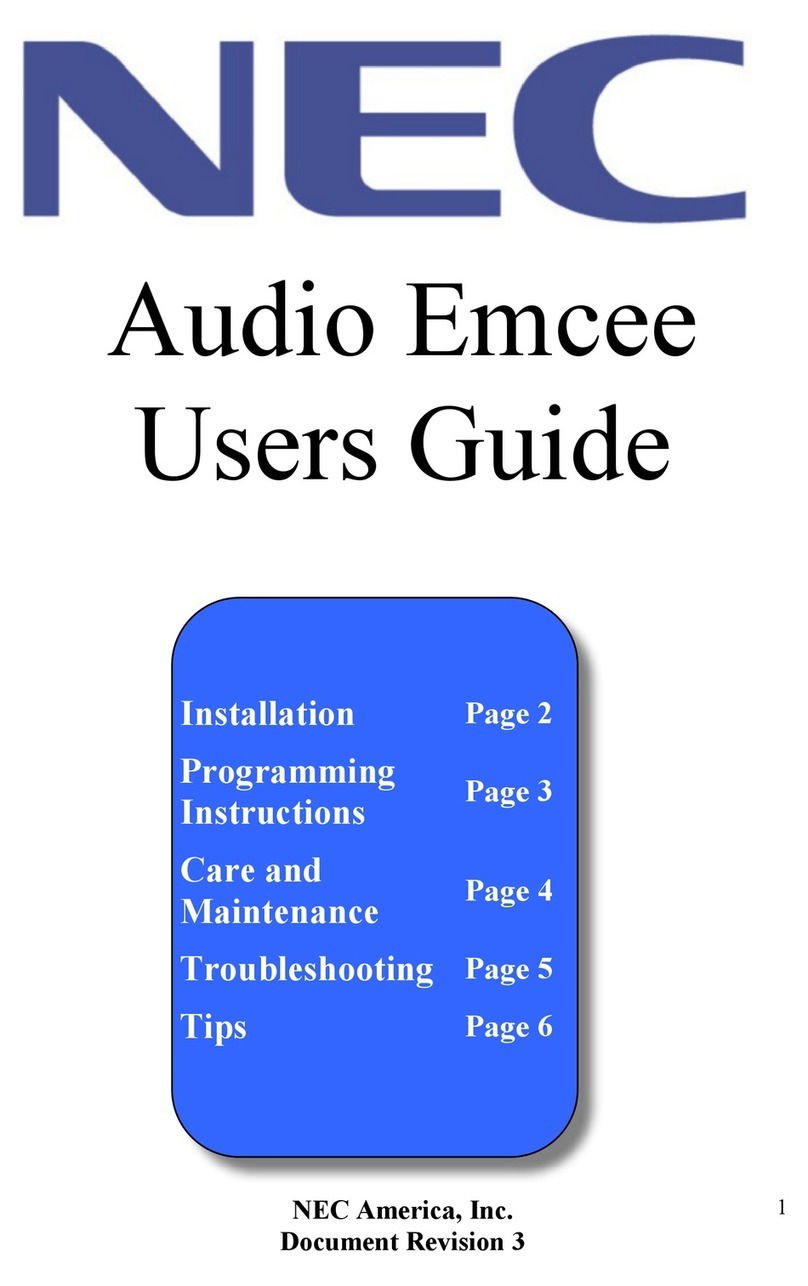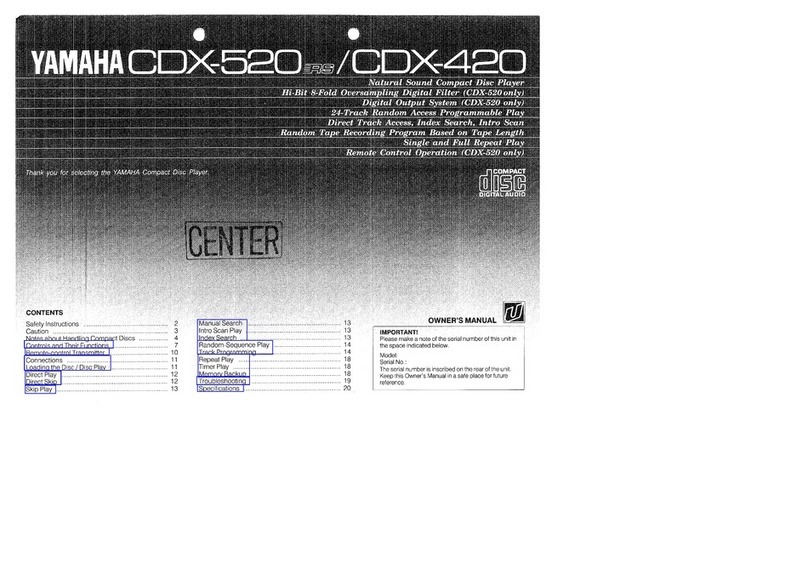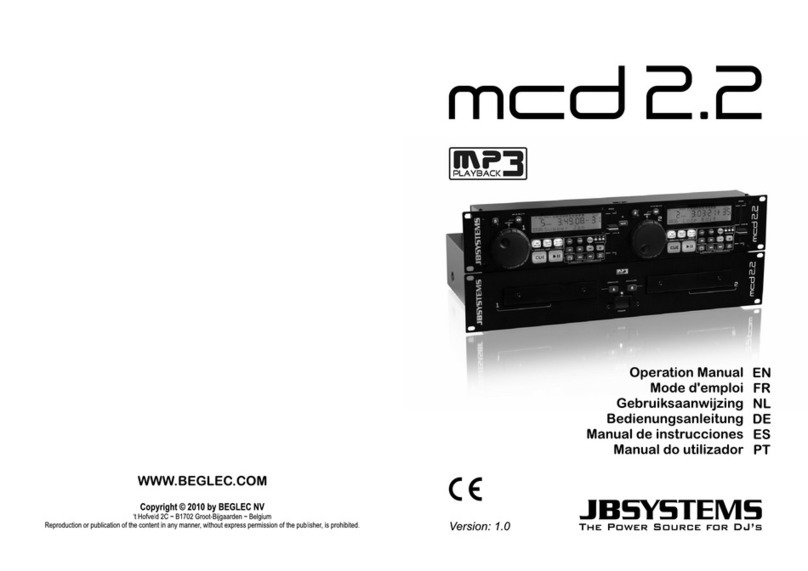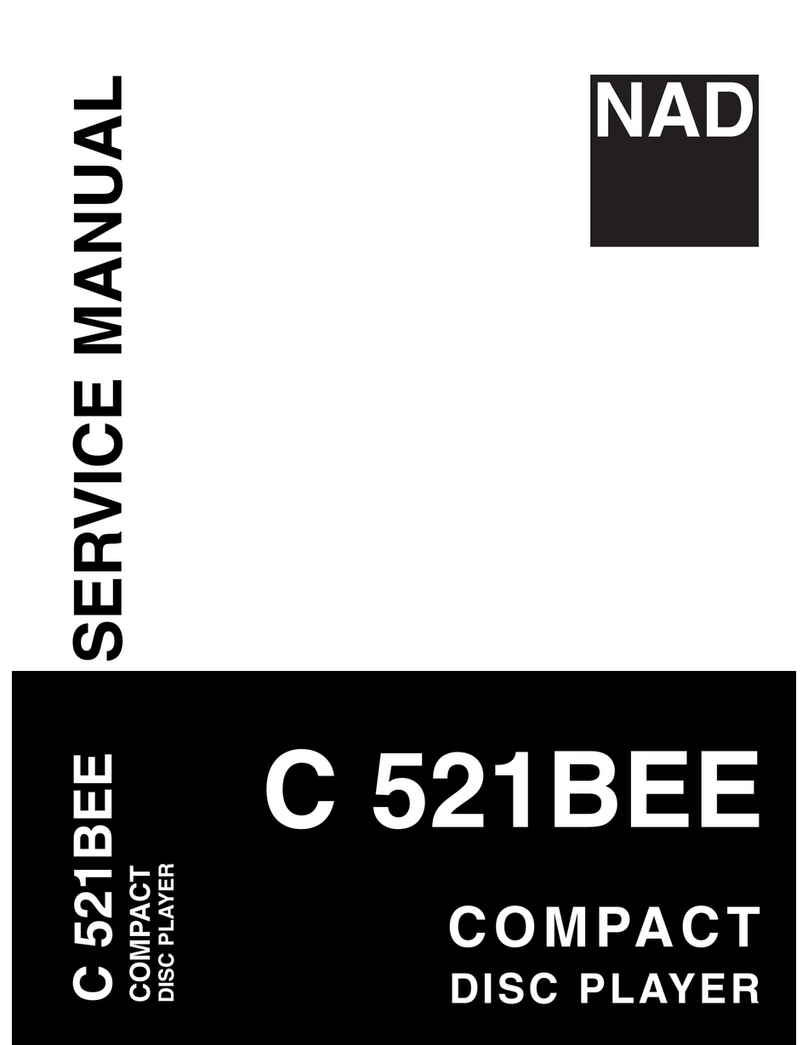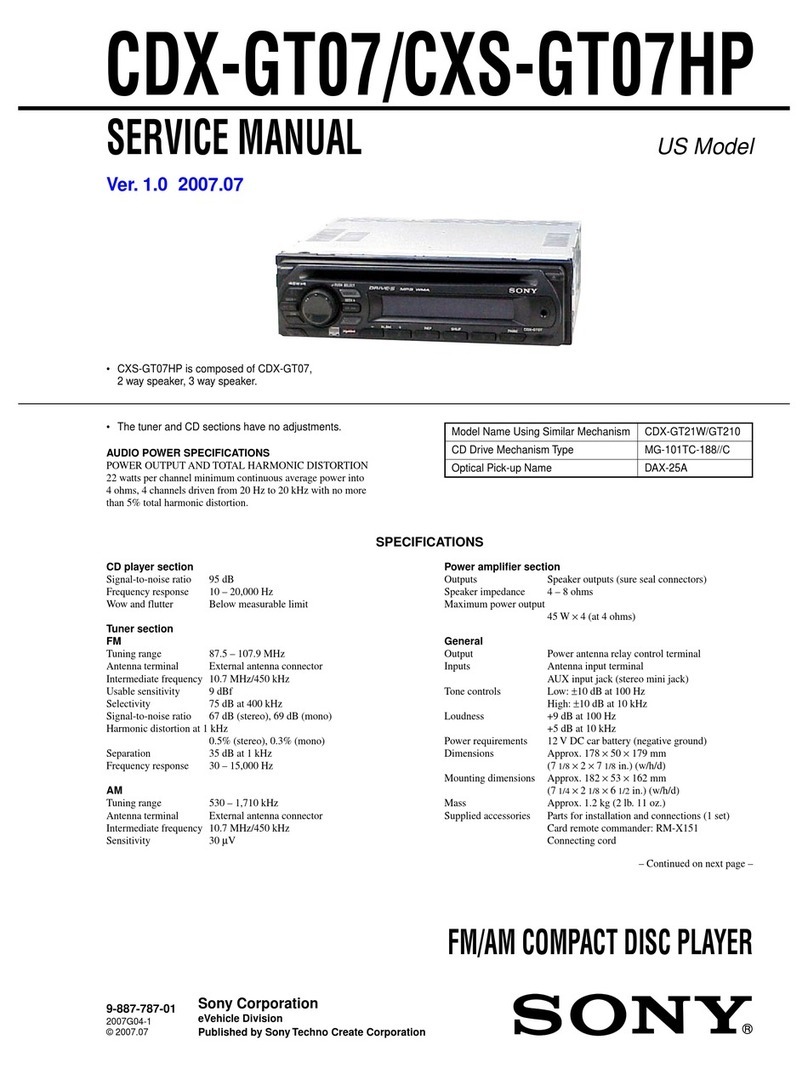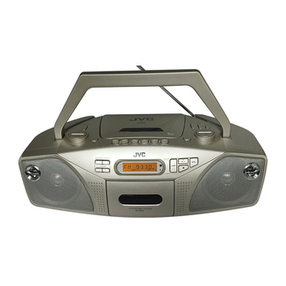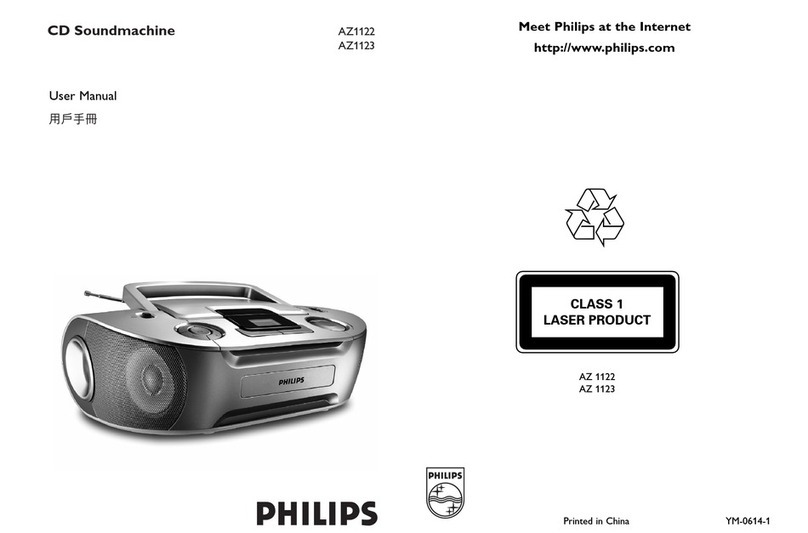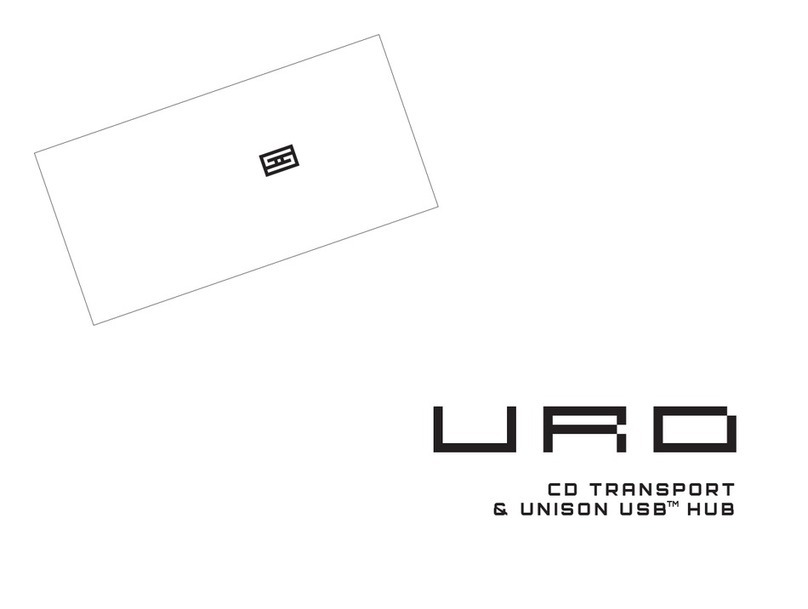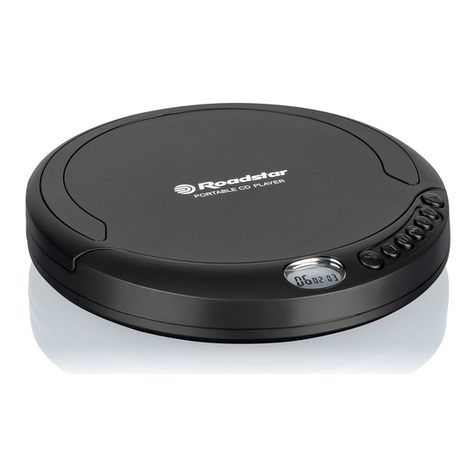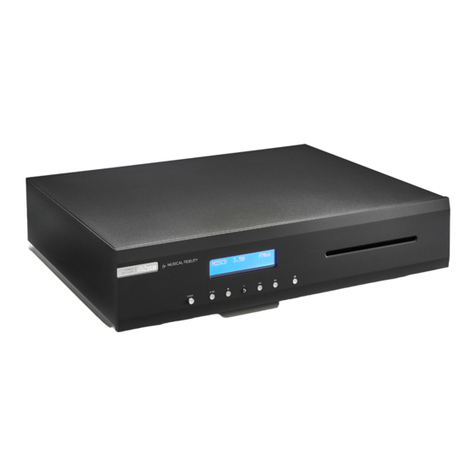Audio Research Reference CD8 User manual

Owner'
s Manual
3900 ANNAPOLIS LANE NORTH / PLYMOUTH, MINNESOTA 55447-5447 / PHONE: 763-577-9700 FAX: 763-577-0323
www.audioresear h. om
Model Reference CD8
CD PLAYER-DIGITAL TRANSPORT

Contents Ref CD8 PDF Manual / 13-08 / 10-24-08
Model Reference CD8
Section age No.
reface. . . . . . . . . . . . . . . . . . . . . . . . . . . . . . . . . . . . . . . . . . . . . . . . . . . . . . . . . . . . . . 1
Introduction . . . . . . . . . . . . . . . . . . . . . . . . . . . . . . . . . . . . . . . . . . . . . . . . . . . . . . . . . 1
Warnings . . . . . . . . . . . . . . . . . . . . . . . . . . . . . . . . . . . . . . . . . . . . . . . . . . . . . . . . . . . . 1
ackaging . . . . . . . . . . . . . . . . . . . . . . . . . . . . . . . . . . . . . . . . . . . . . . . . . . . . . . . . . . . 1
Tube Installation rocedure . . . . . . . . . . . . . . . . . . . . . . . . . . . . . . . . . . . . . . . . . . . . . 2
Installation Instructions . . . . . . . . . . . . . . . . . . . . . . . . . . . . . . . . . . . . . . . . . . . . . . . . 2
ower-up rocedure . . . . . . . . . . . . . . . . . . . . . . . . . . . . . . . . . . . . . . . . . . . . . . . . . . . 2
Shut-Down . . . . . . . . . . . . . . . . . . . . . . . . . . . . . . . . . . . . . . . . . . . . . . . . . . . . . . . . . . 2
Front anel Control Functions . . . . . . . . . . . . . . . . . . . . . . . . . . . . . . . . . . . . . . . . . . . 2
Remote Control Functions . . . . . . . . . . . . . . . . . . . . . . . . . . . . . . . . . . . . . . . . . . . . 2, 3
CD Door Functions/Warnings. . . . . . . . . . . . . . . . . . . . . . . . . . . . . . . . . . . . . . . . . . . . 3
Maintenance . . . . . . . . . . . . . . . . . . . . . . . . . . . . . . . . . . . . . . . . . . . . . . . . . . . . . . . 3, 4
Connections . . . . . . . . . . . . . . . . . . . . . . . . . . . . . . . . . . . . . . . . . . . . . . . . . . . . . . . . . .4
Digital Outputs . . . . . . . . . . . . . . . . . . . . . . . . . . . . . . . . . . . . . . . . . . . . . . . . . . . . . . . 4
Analog Outputs . . . . . . . . . . . . . . . . . . . . . . . . . . . . . . . . . . . . . . . . . . . . . . . . . . . . . . . 4
Servicing . . . . . . . . . . . . . . . . . . . . . . . . . . . . . . . . . . . . . . . . . . . . . . . . . . . . . . . . . . . . 4
Cleaning . . . . . . . . . . . . . . . . . . . . . . . . . . . . . . . . . . . . . . . . . . . . . . . . . . . . . . . . . . . . 4
FCC Rules . . . . . . . . . . . . . . . . . . . . . . . . . . . . . . . . . . . . . . . . . . . . . . . . . . . . . . . . . . . 4
Disposal and Recycling Guidelines . . . . . . . . . . . . . . . . . . . . . . . . . . . . . . . . . . . . . . . .4
Warranty Terms and Conditions . . . . . . . . . . . . . . . . . . . . . . . . . . . . . . . . . . . . . . . . . 5
Specifications . . . . . . . . . . . . . . . . . . . . . . . . . . . . . . . . . . . . . . . . . . . . . . . . . . . . . . . . .5

Model Reference CD8
I
nll
IOII n
D I S P L A Y
REFERENCE CD PLAYER M O D E L C D 8 HIGH DEFINITION ®
PR EV
PLAY N EXT STOP
PAUSE POWER
BALANCED BALANCED AES/EBU
COAX
RIGHT
SE SE
LEFT
ANALOG OUTPUTS
PLYMOUTH, MINNESOTA
MADE IN U.S.A.
120 ATTS
MAXIMUM
50/60 HZ~
THIS DEVICE COMPLIES WITH PART 15 OF THE FCC RULES
OPERATION IS SUBJECT TO THE FOLLOWING TWO CONDITIONS:
(1) THIS DEVICE MAY NOT CAUSE HARMFUL INTERFERENCE. AND (2)
THIS DEVICE MUST ACCEPT ANY INTERFERENCE RECEIVED INCLUDING
INTERFERENCE THAT MAY CAUSE UNDERSIRED OPERATION
MODEL CD8
VACUUM TUBE CD PLAYER
SERIAL
VOLTS
DIGITAL OUTPUTS
•

reface
Please take the time to carefully read this instruction
manual prior to installation or use of your Reference CD8
compact disc player. Because it is a highly advanced elec-
tronic instrument, there are several facts and procedures
you should know before you place it in operation.
Introduction
We believe the CD8 breaks new ground in the retrieval and
transmission of digital data from the CD format. In fact,
that's a large part of the fun: just as in the past, when a
new cartridge and tonearm combination brought music to
life with startlingly improved resolution, subtlety and
dynamics, so too you will discover layers of musical infor-
mation you never knew were there in the mirrored surface
of the compact disc.
What's the reason for this superior performance? Well, a
look inside the CD8 reveals a wealth of proven Audio
Research design philosophy. Circuit boards are Audio
Research engineered, with robust construction, careful
hand soldering and layouts optimized for lowest digital
noise. Sophisticated electronic “jitter stripping” techniques
help minimize jitter in the overall circuit. Advanced
massive power supply design, with two transformers and
extensive regulation, has proved crucial even in digital
applications like the CD8. The BNC and XLR digital outputs
are transformer coupled and are driven by a high-current
balanced line driver. echanical damping theory has also
been applied to internal mounting of key components and
to critical aspects of the transport and chassis structures
(including tuned polymer feet), to minimize vibration-
induced noise.
Both the analog output stage amplification and the power
supply regulation are all-tube and handled by a total of
five class A triode operation 6H30 vacuum tubes (four
for the analog stage and one in the power supply), and one
6550C regulator vacuum tube.
A 24 bit digital-to-analog converter and a high-current pure
class A analog output stage allow the CD8 to be used with
a line-level preamplifier or integrated amplifier. Both single-
ended (RCA) and balanced (XLR) outputs are included. Al-
ternatively, the owner may use the CD8 as a high-quality
CD transport in conjunction with an external digital
processor.
The CD drive mechanism itself represents the latest think-
ing from digital engineers, and offers performance clearly
superior to older drives. In part, this is because even the
servos of the CD8 drive operate fully in the digital domain,
whereas older transport models were actually hybrid
designs using analog servos, which placed greater demands
on power supply reserves. The CD8 laser also has a
superior eye pattern for more effective resolution of CD
data and, again, lower jitter.
In appearance, the CD8 is pure Audio Research: heavy
bevelled front panel, with handles flanking the controls on
the right and the readout display on the left. Both controls
and display readout are recessed within bevelled openings
for a more sculptured appearance. A convenient handheld
remote control of all front-panel functions and additional
functions is also included.
On the rear chassis panel you will find BNC coaxial and
XLR digital outputs. (An RCA/BNC adaptor is included with
each unit.) Analog outputs include single-ended (RCA) and
balanced (XLR).
Warnings
1. To prevent fire, or shock hazard, do not expose your
CD8 to rain or moisture.
2. This unit contains voltages which can cause serious
injury or death. Do not operate with cover removed.
Refer servicing to your authorized Audio Research dealer
or other qualified personnel.
3. The detachable power cord on your CD8 is equipped
with a heavy gauge, 3-conductor cable and a standard
three-prong grounding plug. For absolute protection,
do
not defe at the ground power plug.
This provides
powerline grounding of the CD8 chassis to provide
absolute protection from electrical shock.
4. For continued protection against fire hazard, replace the
fuse only with the same type and rating as specified at
the fuse holder.
5.
Do not operate the CD8 player without the supplied
CD8 clamp installed on the CD. Gently place clamp on
disc to prevent damaging spindle mechanism.
6.
Whenever the CD8 power is on, the door covering the
drive mechanism/tray area should remain fully closed
after inserting or removing a CD, so as not to block
any of the perforated area of the top cover. Following
this procedure will maintain proper ventilation to pre-
vent over heating the unit and also minimize dust
intrusion on the lens and drive mechanism.
ackaging
Save all packaging in a dry place away from fire hazard.
Your CD8 compact disc player is a precision electronic
instrument and should be properly cartoned any time ship-
ment is made. You may not have occasion to return your
unit to the factory for service, but if that should prove
necessary, or other occasion requiring shipment occurs, the
original packaging will protect your CD8 from unnecessary
damage or delay.
Model Reference CD8
1

Tube Installation rocedure
BEFORE O ERATING THE CD8:
Carefully remove each of the six vacuum tubes (five 6H30,
one 6550C) from their protective foam blocks and install
them in their sockets on the circuit board, matching the “V”
number on the tube with each matching numbered tube
socket. The 6550C is mounted horizontally in the socket on
the metal bracket.
When installing or removing the 6550C vacuum tube in
the V5 socket location, grasp the metal bracket with one
hand while inserting the tube with the other to prevent
flexing of the circuit board and possible damage to it.
Note: double damping rings are installed at the factory on
each 6H30 tube for maximum sonic performance.
Installation Instructions
While the CD8 does not dissipate an unusual amount of
heat, it is important that it be provided with reasonable air-
flow to assure long, trouble-free operation. In addition, the
following installation guidelines will help insure maximum
sonic performance as well as reliable service.
1. Upright and level horizontal mounting is mandatory,
preferably on solid, non-resonant shelving. Allow suffi-
cient space for tube convection cooling. Do not block
the ventilation holes when the unit is turned on.
2. Do not stack the CD8 on top of another component: not
only could this cause overheating, but hum may be
introduced into the system.
3. Do not place any objects on top of the CD8; its suspen-
sion feet are tuned for the specific weight of the CD8.
4. Do not place or operate your CD8 on a soft or
irregular surface such as a rug. This can prevent proper
leveling and restrict ventilation
5. Do not operate your CD8 without the top and bottom
covers installed. These are required both for safety
as well as shielding from interference (except in service
operations by qualified personnel).
6. If side-by-side mounting with other equipment is
employed, place the CD8 to the left of the other chassis,
so as to provide maximum spacing between the trans-
formers of the CD8 and the other component.
ower-up rocedure
Once plugged into the power receptacle, after the tubes
have been installed (see above), push the front panel Power
switch to turn on the CD8. The central green front panel
LED will glow dimly for about a 40 second circuit warm-up
interval with the output automatically muted. When the
LED glows brightly, the CD8 is ready for operation.
Once powered up and operational, with the CD door fully
closed, the unit will default to the operate setting (display,
transport and front panel controls are activated).
Because the CD8 reaches its full sonic potential from “cold”
in a shorter warm-up time period than a solid state
CD player, it's recommended that it be powered off for any
extended time it is not in use. This will save on tube life.
Shut-Down
1. Set preamplifier ute switch to “ ute” position.
2. Press CD8 front panel Power switch to turn unit off.
Front anel Control Functions
OWER O:The Power switch turns the CD8 completely on
for operation (indicated by the LED being brightly lit), each
time preceded by a warm-up interval of about 40 seconds
when the LED is dim and the output is automatically
muted. Press power switch again to turn CD8 off-indicated
by unlit LED.
AUSE II:Interrupts play (display will read “PAUSE”).
Release PAUSE by pressing it a second time to resume
playing disc.
STO n:Stops play. (Number of tracks and total disc track
time appear on display.)
LAY
l
:Starts play.
CD door must first be fully closed.
Begins to play first track unless another is selected. Restarts
track if pressed during play. (Track number and elapsed
track time appear on display.)
REV
|
n
:Selects the previous track to play. Continue
pressing to cycle backward through previous tracks. (Track
number will appear on display.)
NEXT
l
|
:Selects the next track to play. Continue pressing
to cycle forward through tracks. (Track number will appear
on display.)
Remote Control Functions
The remote control unit includes all of the above described
CD8 front panel control functions plus the following
additional functions. (Functions in [ ] indicate labeling
abbreviations appearing on remote control unit.)
STANDBY [STBY]: Press to stop play, turn off display and
deactivate transport operation. As indicated by lit green
LED, power remains on to all vaccum tubes in audio section
and power supply. Press again to light display and reacti-
vate transport functions.
0-9 BUTTONS: Pressing numbered button(s) corresponding
to the disc track number will advance disc to desired track.
Also used to select tracks when compiling a custom disc
playback program (see PROGRA [PROG] function descrip-
tion below).
SCAN: With a stopped CD and the CD door closed, press
SCAN and the first 10 seconds of each track will be played
in sequence. (“SCAN” will light up on display, then 10
seconds are counted out next to each track number.) To
Model Reference CD8 Ref CD8 PDF Manual / 13-08 / 12-31-09
2

hear a track in full that player is presently scanning, press
SCAN button again which will cancel SCAN function.
ROGRAM [ ROG]: Allows compiling a custom track
selection and playback order of up to 20 tracks on a disc.
With the player in STOP mode, enter the desired first track
number and then press the PROGRA button. The word
“PROGRA ” will light and the display will show the total
number of tracks programmed and total programmed time.
If a second track selection is entered, the word “PRO-
GRA ” flashes, indicating that other track(s) have already
been stored in the program memory. Press the PROGRA
button to save the second track selection. Repeat procedure
to program additional tracks as desired. This programming
procedure, with readout of the cumulative total number of
programmed tracks and total programming time (including
time between tracks), works for any of the first 13 num-
bered tracks on a disc. You may program track numbers
higher than 13, but from then on no track time information
will appear on the display. To preview a program before
playing it, press PLAY and then use the NEXT
l
|
and
PREV
|
n
buttons to cycle through track selections. Press-
ing PLAY will begin playing program. Pressing STOP once
will stop program play. Pressing PLAY again will resume
play from beginning of program. To cancel program, press
STOP twice.
TIME: Pressing and releasing TI E repeatedly will cycle
through the following information on the display: current
track time elapsed (default setting initially seen on display),
total disc time elapsed, and total disc time remaining.
A/B: Press the A/B button once while music is playing, then
press it again; the musical passage in the interval between
pressing the button is then repeated in a loop until
pressing the A/B button once again to discontinue it.
Display reads “A —B” to show activation. Note: you must
discontinue the A/B loop before pressing PLAY to resume
normal playback.
nn
:Pressing and holding this button down will fast
search backward through the track that is playing until it is
released. Rate of search accelerates as button is held down.
ll
: Pressing and holding this button down will fast
search forward through the track that is playing until it is
released. Rate of search accelerates as button is held down.
SHUFFLE [SHUF]: Press SHUFFLE. “SHUFFLE” lights up on
display, and tracks will now play in random order. Press
SHUFFLE again to return to normal play sequence.
RE EAT [RE ]: Press REPEAT once to repeat the entire
disc continuously (“REPEAT” lights up on display). Press
REPEAT once more to continuously repeat the track now
playing (“REPEAT 1” lights up on display). Press REPEAT
once again to discontinue repeat mode.
DIS LAY DOWN/ DIS LAY U [ DS DN / DS U ]:
Decreases/Increases display intensity, offering four levels
of brightness and display off.
CD Door Functions/Warnings
•
Do not attempt to play a CD without first installing the
supplied CD8 magnetic disc clamp on the CD.
• Use only the supplied CD8 clamp in your CD8 player.
• CD door must be fully closed for the CD8 to operate.
• All front panel and remote control functions and display
are deactivated when CD door is open, to prevent
exposure to laser. Do not attempt to bypass this lockout
feature. The CD8 will stop playing if the CD door is
opened while running.
• If the CD door is closed without a CD in the player and
the CD8 is powered up, the display will read "No disc".
• If a CD is inserted (label side up) in the CD8, the CD door
is fully closed and the CD8 is powered up, the CD will
spin for a few seconds while the track information is
accessed. The number of tracks and total disc time will
then be displayed, indicating the CD is ready to play.
• Keep the CD door closed when the CD8 is turned off and
not in use to keep dust out of the lens and drive area.
•
When the CD8 power is on, keep the CD door fully
closed (except to change CDs) to allow heat to escape
through all of the top cover holes and prevent over-
heating of the unit.
Maintenance
THE CDs
• Keep the shiny surface of the CD clean and free of
scratches. Use a soft lint-free cloth and always wipe the
CD in a straight line from center to outer edge.
• Never use cleaning agents for conventional records on
CDs.
• Detergents or abrasive cleaning agents should not be used
on CDs.
ROBLEMS AND THEIR LIKELY CAUSES
If a problem occurs, run through the points listed below
before taking your player in for repair.
Check whether:
– condensation has formed on the lens of the laser due to
a dramatic change in temperature; this will disappear
naturally after some time.
– the CD has been inserted correctly with the printed side
up and that there is a CD in the compartment and the
cover is fully closed.
– the CD is dirty, badly scratched, warped or defective.
– the player has been inadvertently connected to the
PHONO inputs of the preamplifier.
Model Reference CD8
3

If the problem remains, try to clear it by switching
the player off and on again, or unplugging it, waiting 60
seconds, and plugging it in again. If this fails to help,
consult your Audio Research dealer.
Under no circumstances should you attempt to repair
or modify the player yourself as this will invalidate the
warranty!
Connections
The CD8 offers two standard digital output options. Which
option is best for your system will depend on your personal
listening preference, the nature of your system installation
requirements, and the options allowed by your external
digital processor, if one is used.
WARNING: The digital outputs supply only a digital signal
and should therefore only be connected to an input which
is suitable for this signal. Never connect either of these
digital outputs to a non-digital input of a preamplifier (such
as those labeled CD, AUX, PHONO, TAPE, etc.) or to a
power amplifier. To do so is to risk damage to your system
and may void any or all warranties involved.
Digital Outputs
BNC COAXIAL: Use 75-ohm impedance coaxial cable with
locking BNC-type connectors. An RCA/BNC adaptor is also
supplied.
BALANCED XLR: For connection to digital processors
having the AES/EBU-Standard interface.
Analog Outputs
SINGLE-ENDED (RCA): For connection to the inputs of a
line-level preamplifier or integrated amplifier,
BALANCED (XLR): For connection to the balanced inputs
of a line-level preamplifier.
Servicing
CAUTION: Your CD8 contains sufficient levels of voltage
and current to be lethal. Do not tamper with a component
or parts inside the unit. Refer any needed service to
your authorized Audio Research dealer or other qualified
technician.
Should service be necessary, please contact your Audio
Research dealer, or Audio Research Customer Service
(763) 577-9700.
Cleaning
To maintain the visual appearance of your CD8,occasionally
wipe the front panel and top cover surfaces with a soft
damp (not wet) cloth to remove dust. A mild, non-alkaline
soap solution may be used to remove fingerprints or similar
smudges. Cleaners containing abrasives should
not
be used
as they will damage the brushed grain of the front panel
finish, as well as the LED display window. A dry 2-inch
pure bristle paint brush works well to remove dust from
bevels, reliefs and switches. The CD8 CD compartment
may be gently dusted: carefully avoid touching the laser
assembly area to prevent possible damage.
FCC Rules
NOTE: This equipment has been tested and found to
comply with the limits for a Class B digital device, pursuant
to Part 15 of the FCC Rules. These limits are designed to
provide reasonable protection against harmful interference
in a residential installation. This equipment generates, uses
and can radiate radio frequency energy and, if not installed
and used in accordance with the instructions, may cause
harmful interference to radio communications. However,
there is no guarantee that interference will not occur in a
particular installation. If this equipment does cause harmful
interference to radio or television reception, which can be
determined by turning the equipment off and on, the user
is encouraged to try to correct the interference by one or
more of the following measures:
Reorient or relocate the receiving antenna.
Use interconnect cables of no more then one meter in
length.
Increase the separation between the equipment and
receiver.
Connect the equipment into an outlet on a circuit dif-
ferent from that to which the receiver is connected.
Consult the dealer or an experienced radio/TV
technician for help.
Disposal and Recycling Guidelines
To dispose of this electronic product, do not place in land-
fill. In accordance with the European Union Waste Electri-
cal and Electronic Equipment (WEEE) directive effective
August 2005, this product may contain regulated materials
which upon disposal require special reuse and recycling
processing.
Please contact your dealer or importing distributor for
instructions on proper disposal of this product in your
country. Or, contact Audio Research Corporation (763-577-
9700) for the name of your importing distributor and how
to contact them.
Packing and shipping materials may be disposed of in a
normal manner.
Model Reference CD8
4

Limited Warranty
Audio Research Corporation products are covered by a 3-
Year Limited Warranty, or a 90-Day Limited Warranty
on vacuum tubes. This Limited Warranty initiates from the
date of purchase, and is limited to the original purchaser, or
in the case of demonstration equipment, limited to the
balance of warranty remaining after original shipment to
the retailer or importer.
In the United States, the specific terms, conditions and
remedies for fulfillment of this Limited Warranty are listed
on the warranty card accompanying the product in its ship-
ping carton, or may be obtained from the authorized retail-
er or from the Audio Research Customer Service Depart-
ment. Outside the United States, the authorized importing
retailer or distributor has accepted the responsibility
for warranty of Audio Research products sold by them.
The specific terms and remedies for fulfillment of the
Limited Warranty may vary from country to country.
Warranty service should normally be obtained from the
importing retailer or distributor from whom the product
was purchased.
In the unlikely event that technical service beyond the abil-
ity of the importer is required, Audio Research will fulfill
the terms and conditions of the Limited Warranty. Such
product must be returned at the purchaser's expense to the
Audio Research factory, along with a photocopy of the
dated purchase receipt for the product, a written descrip-
tion of the problem(s) encountered, and any information
necessary for return shipment. The cost of return shipment
is the responsibility of the purchaser.
Specifications
OUTPUT , ANALOG: ( tereo)
1. Balanced XLR 3.6V RMS (+11.1dBv) max.
2. Single-Ended RCA 1.8V RMS (+5.1dBv) max.
OUTPUT IMPEDANCE: (Analog)
660 ohms BAL, 330 ohms SE.
FREQUENCY RE PON E:
0.5–20,000Hz +0 -0.5dB.
IGNAL TO NOI E RATIO: 108dBA
DI TORTION: .03% 1kHz
RE OLUTION: 24 BIT DAC.
CHANNEL EPARATION: 100dB 1kHz.
OUTPUT , DIGITAL: (to external Digital-to-Analog Converter)
1. XLR Balanced AES/EBU 110-ohm 4V P-P.
2. BNC coax SPDIF 75-ohm 0.7V P-P.
Specifications subject to change without notice.
©2008 Audio Research Corporation.
IGNAL FORMAT (disc):
Sampling frequency: 44.1kHz.
Quantization Bit: 16bit linear per channel.
Channel bit rate: 4.3218Mb/sec.
Channel modulation code: EFM (8 –14 modulation).
Error correction: CIRC (cross interleave Reed
Solomon Code).
DRIVE MECHANI M (top load):
Wow & Flutter: Unmeasureable (Quartz stability).
Discs: Accepts 5" (12cm) and 3" (8cm) sizes.
OPTICAL PICKUP:
Type: 3-beam LDGU (Laser Diode & Grating Unit), with
holographic diffraction light pen.
Laser: GaAIAs semiconductor, 780nm, 0.5mW maximum
output.
Servo: Digitally-controlled low-inertia linear positioning
actuator.
JITTER REDUCTION: High-stabillity crystal-controlled
re-clocking for all outputs.
DI PLAY: Six-digit vacuum fluorescent, with optical filter.
TUBE COMPLEMENT: (4)-6H30P dual triodes, plus
(1 each) 6550C and 6H30P in power supply.
POWER REQUIREMENT (detachable power cord):
100-135VAC 60Hz (200-270VAC 50/60Hz), 120 watts
maximum. (2 watts maximum when unit is turned off)
COMPLIANCE: RF Interference complies with FCC and CE
MAR .
FRONT PANEL CONTROL FUNCTION :
PREV
|
n
selection
PLAY
l
disc
NEXT
l
|
selection
PAUSE II program
STOP ndisc
POWER Oon/off
INFRARED REMOTE CONTROLFUNCTION :
(Standard RC5 code, 30ft max distance)
0–9 digit entry keys
SCAN ten seconds each track
PAUSE program
REP track/disc
STOP program
PLAY disc
SHUF random sequence play
|
nn
search, REV
ll
|
search, FWD
STBY power on/off
PROG enters selection on program list
TIME elapsed, remaining track; remaining disc
A/B repeats segment
|
n
previous track
l
|
next track
DIMEN ION : 19" (48 cm) W x 51/4" (13.4 cm) H x 153/8"
(39.0 cm) D. Handles extend 11/2" (3.8 cm) forward of the front
panel. Rear connectors extend 3/4" (1.9 cm).
WEIGHT: 32.5 lbs. (14.8 kg) Net; 43 lbs. (19.5 kg) Shipping.
5
Model Reference CD8 Ref CD8-1 PDF Manual / 13-08 / 3-22-10
Table of contents
Other Audio Research CD Player manuals

Audio Research
Audio Research CD9SE User manual
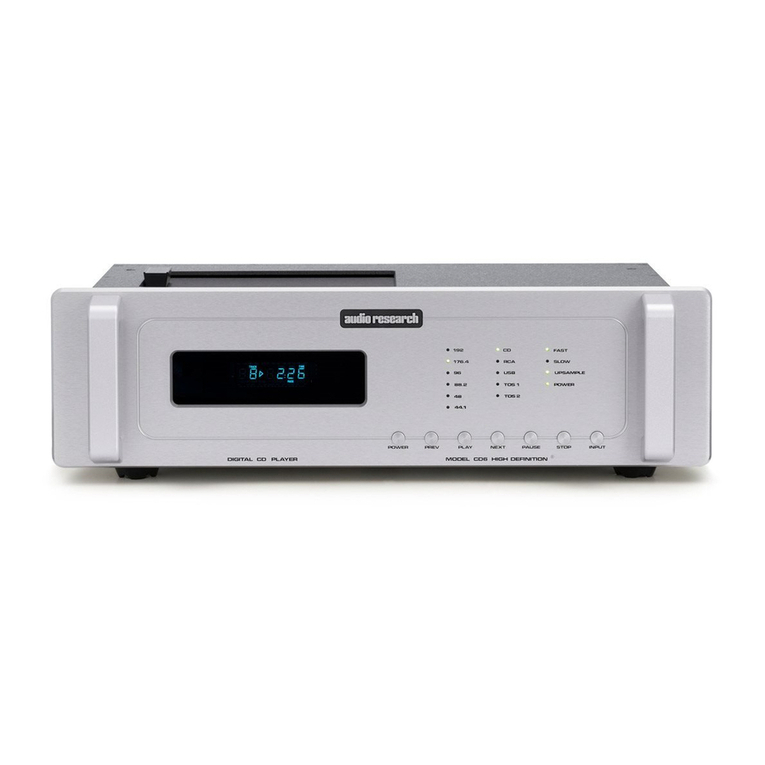
Audio Research
Audio Research CD6 User manual

Audio Research
Audio Research CD3 User manual

Audio Research
Audio Research CD1 User manual
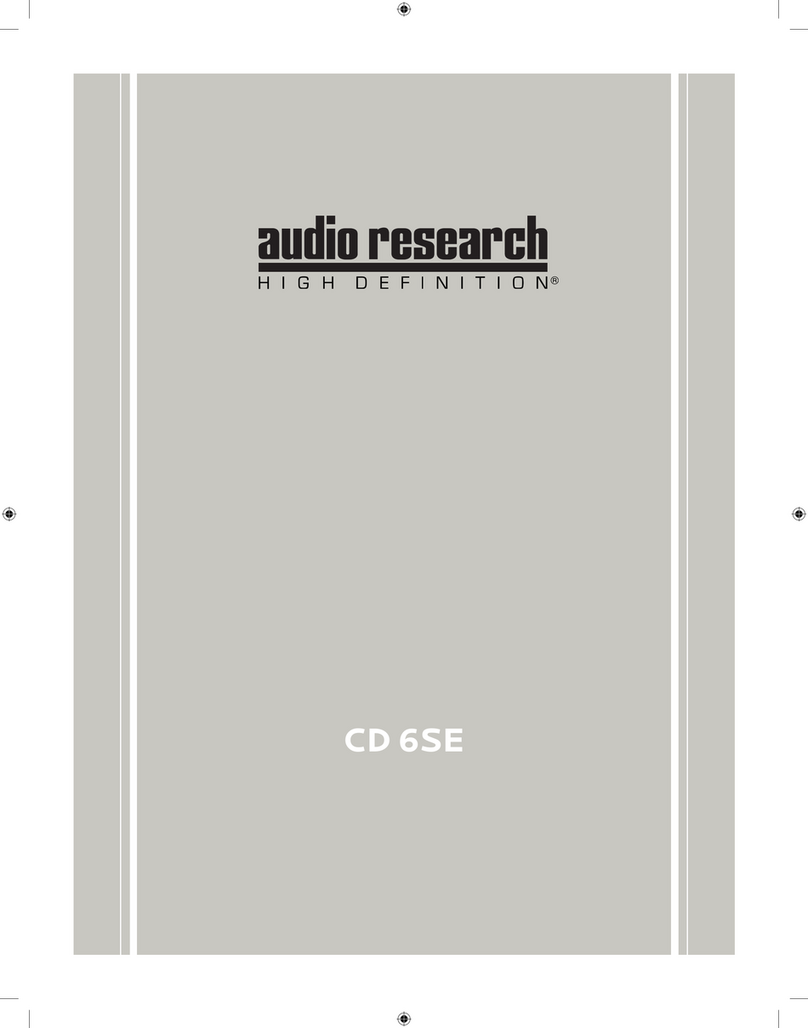
Audio Research
Audio Research CD 6SE User manual
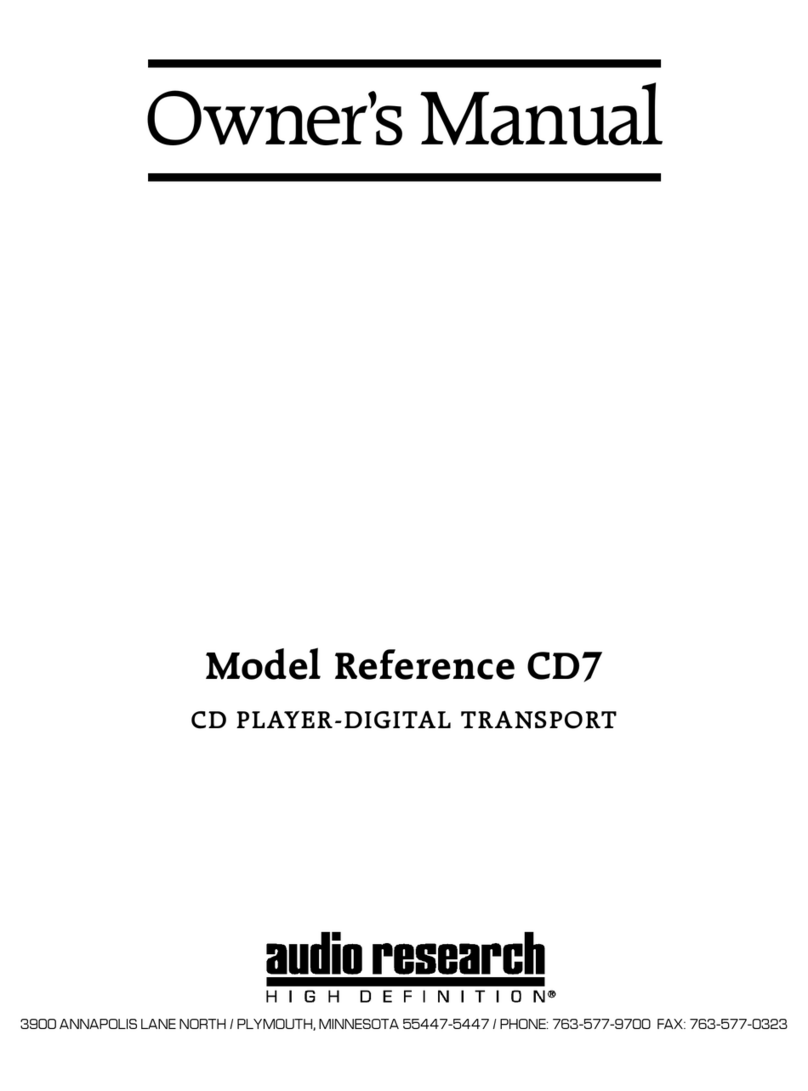
Audio Research
Audio Research Reference CD7 User manual
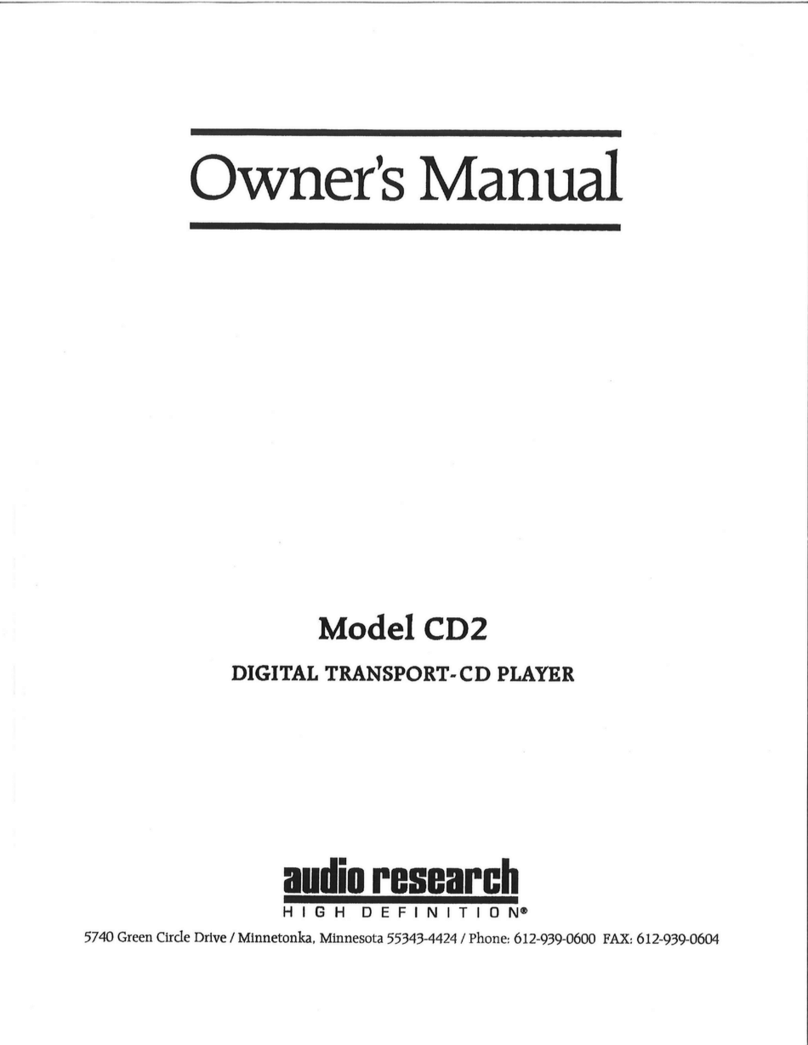
Audio Research
Audio Research CD2 User manual
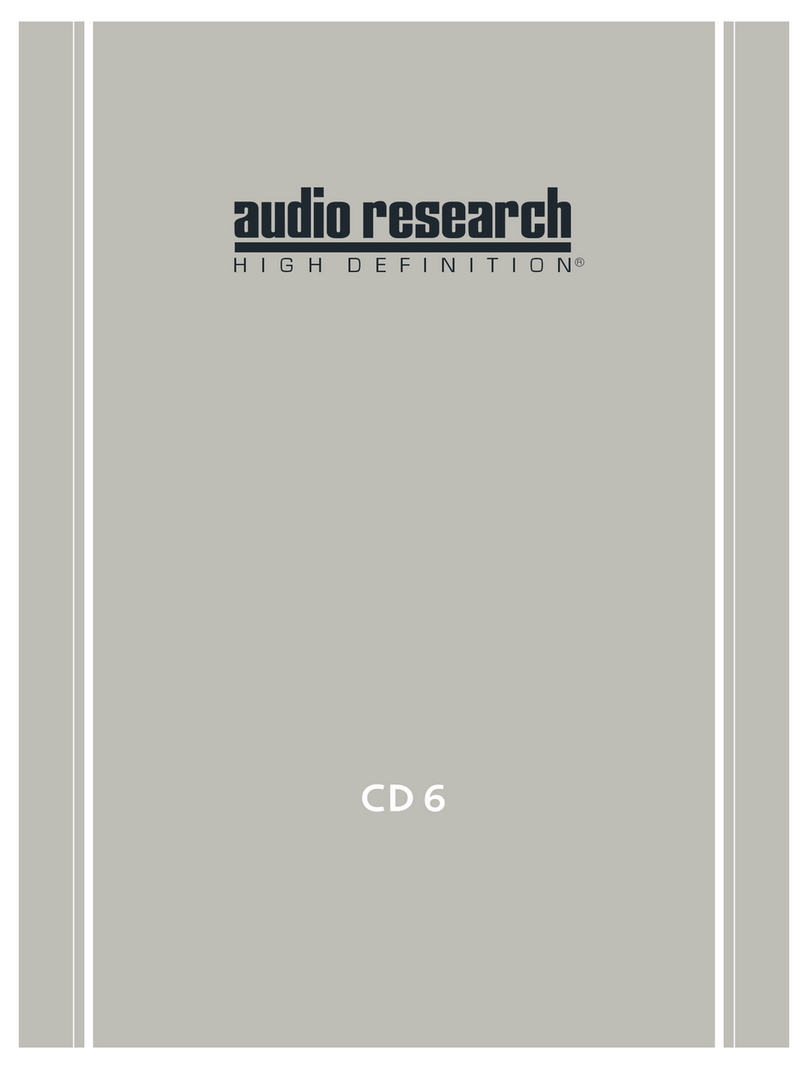
Audio Research
Audio Research CD6 User manual
